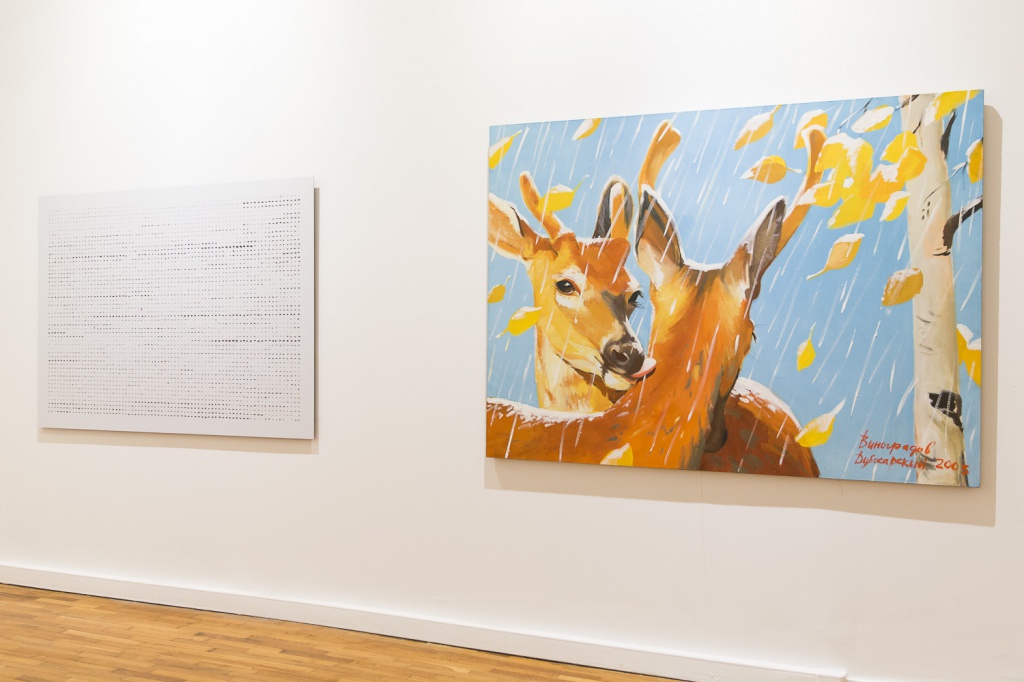7th Moscow International Biennale of Contemporary Art
New Tretyakov Gallery
19 September 2017 - 22 January 2018
Curated by Yuko Hasegawa
The 7th Moscow International Biennale of Contemporary Art in the New Tretyakov among others featured works from the Gazprombank corporate collection. This year Moscow Biennale of Contemporary Art was curated by a different team. Iosif Bakstein, the commissar of all previous exhibitions, was replaced by the Board of Experts headed by Semyon Mikhailovsky, the Commissar of the Russian Pavilion at the 2017 Venice Biennale. The Board selected the venue for the Biennale as well as its curator. Yuko Hasegawa, Chief Curator of the Museum of Contemporary Art in Tokyo, was chosen to curate the project dedicated to the Year of Ecology in Russia. Environmental protection is a subject all too well familiar to her: she curated ecology-themed exhibitions at the 7th Istanbul Biennale, 29th Sao Paolo Biennale and Biennale in Sharjah in 2013.
As a result, the Hasegawa-curated main project that for the first time in the history of the Moscow Biennale was housed at the New Tretyakov building in the Krymsky Val was dedicated to the conflict between technological progress and nature. The juxtaposition is all-embracing and can incorporate a whole range of other topical issues such as complex interaction between cloud-dwelling (digital) youth and deep-rooted (like trees in an age-old forest) conservatives of older generations. The concept is reflected in the title of the whole project – "Clouds - Forests".
Russian artists submitted more than 600 applications and through competitive selection, another novelty of this year, Hasegawa chose 51 works. Some of the selected artists are very young. A number of works – by Alina Gutkina, Mikhail Tolmachev, as well as art-duo of Vinogradov-Dubossarsky, one of the most significant creative units in the Russian art of the 1990s, – come from the Gazprombank collection.
Moscow-based Ilya Fedotov-Fedorov who works in the genre of BioArt was represented at the Biennale by his early works dating to the period when he had studied genetics and before he joined Iosif Bakstein-founded Institute of Contemporary Art (ICA) and School of Contemporary Art Free Workshops. His drawings resemble either ancient hierograms or foliage patterns but in fact they are nothing other than the names of the artist’s pet ants translated into the binary code. Alina Gutkina, another ICA alumna, reminds the Biennale viewers about a necessity to boycott commercial brands: participants of her performance scribble advertisements right on their own skin.
The subject of virtually all works by American artist Marina Zurkov is natural disasters. In her animated "Mesocosm" animals and birds roam around an oil-production generated sinkhole: all the characters in the eco-system interact with each other through a software devised by the artist.
In the work of the French artist Marie-Luce Nadal the world is ruled by a God of Mist. This character draped in a costume of a mythical hero on a black-and-white photograph at the entrance into the room observes her Fabrique de nuages (Cloud Factory) installation: right in front of our eyes machines placed into transparent cubes generate clouds of steam.
Unlike these ethereal substances the installation by British artists Revital Cohen and Tuur Van Balen forebodes a real storm. A black door in a black corridor hides a huge plant entangled in a jumble of wires. Motionless, without any light or air movement, immersed into a kind of damp immobility that hangs in the air a moment before the storm, it makes us think about the future of all the plants (and not only plants) on the planet.
Equally permeated by apocalyptic forebodings is the impressive installation by the Turner Prize-winning French artist Laure Prouvost. Entitled "All behind, we'll go deeper, deep down and she will say" the work consists of three video monitors placed in a room with puddles of garbage scattered around. The viewer’s task (nearly impossible to implement) is to finish viewing at least one video without being distracted by the garbage around them.
At the same time, you can forever admire poignant "Deer" in Vladimir Dubossarsky and Alexander Vinogradov’s painting.
They say that if you add up all the videos in the main project you end up with six hours of non-stop video art. Most of it will surely be taken by the new interactive project of Bjork, singer, actor, and artist. The installation is a journey across the videos from the Icelandic diva’s album "Vulnicura" that the viewers enjoy through VR glasses. You will find yourself inside a damp Icelandic cave, on the sea shore outside Reykjavik or even inside the singer’s mouth. Alongside this shocking and not always pleasant experience the custom made for the exhibition works of her former lover Matthew Barney look modest and unimposing - despite the Biennale’s most expensive price tag of $1 mln.

Vladimir Dubossarsky and Alexander Vinogradov. "Deer". 2003. Photo: Natalya Polskaya.

Alina Gutkina. From the series "I AM". 2010. Photo: Natalya Polskaya.
Michail Tolmachev. From the series "Earth - Air". 2013. Photo: Natalya Polskaya.
